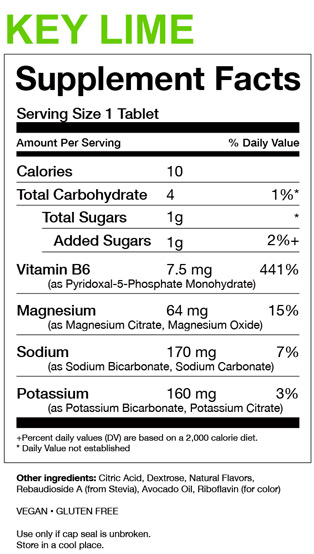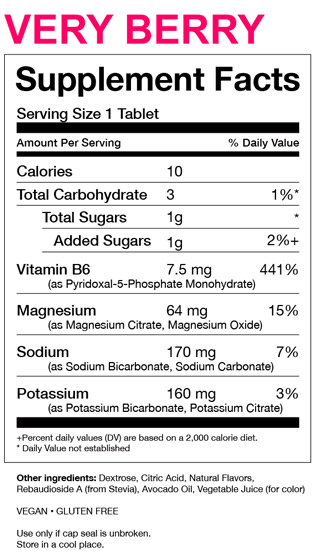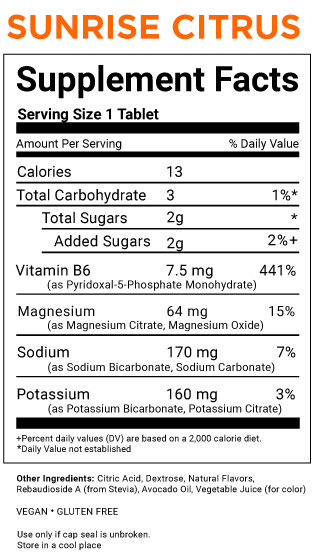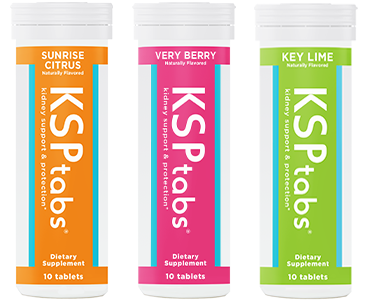Our FAQ’s answer some of the most popular questions about kidney health, natural kidney stone prevention and KSPtabs. Take a look and see if your question is listed below.
How many KSPtabs should I take per day?
The recommended dosage is 2-3 tablets daily. Since these key elements are not stored well in the body, it is recommended to split the doses to am and pm. This will allow the urine to contain these elements in it throughout the day. Each tablet is scored to make it easy to split in half. This promotes easy dosing options for users who want to maintain flavorful hydration and balanced minerals throughout the day.
Will KSPtabs interact with my current medication?
KSPtabs provide a natural approach to kidney stone prevention. They consist of a blend of vitamins, minerals and herbs to promote good kidney health. Natural ingredients often don’t interact negatively with prescription medication, but it is recommended that you speak with your physician before taking KSPtabs. Your physician will be able to advise you per your specific health requirements.
Can I take these if I’m pregnant?
Yes, KSPtabs are safe to take during pregnancy and while breastfeeding. The Mayo Clinic recently did a study that found pregnancy increases the risk for women to develop first-time symptomatic kidney stones. Please review the ingredients below for more detail and consult your physician if you have any questions.
Do I still need to see my urologist if I take KSPtabs?
Routine visits with a physician to ensure best health is always recommended. It’s encouraged that you speak with your urologist regarding your health, future appointments, and how you are using KSPtabs to promote your kidney health.
Are the tubes recyclable?
Simply remove the label and the bottom tube can be recycled. The top stopper must be discarded and is not recyclable.
Is it okay if a tablet is discolored?
It’s normal for the top tablet face nearest to the desiccated stopper to show some minor discoloration. The face of the top tablet will show minor mottling (spots or smears of color) because of its proximity to the desiccant in the stopper as its absorbing any available moisture. The other side of the tablet should have the same appearance as the others in the tube. There shouldn’t be any impact to the tablets flavor, odor, or solution appearance as a result of the mottling.
Why do kidney stones form?
Kidney stones can form for a variety of reasons. Typically, these causing factors are dependent upon your health. They form from minerals and salts that typically remain either soluble or dissolved in your urine. Calcium oxalate salt normally exists in its dissolved form, but can also be in a solid or crystalline form. This is what is seen as a kidney stone.
A high concentration of soluble salt can result in the formation of solid crystals. The crystallization of the salt is usually a result of an imbalance of various chemical elements and their environment.
Even in the dissolved form, these chemical elements in the urine usually remain. Your urine contains inhibitors that often make it difficult for soluble salt crystals to develop, allowing the elements to remain in high urinary concentrations. Ultimately, this reduces the chance of forming a crystal.
Kidney stone inhibitors are increased from both our diet and cells. Consuming Citrate, B6, and Magnesium can influence kidney stone inhibitors, while our cells produce proteins that can help prevent stone production as well. Kidney stones will start to form when situations promoting salt crystal development outweigh the factors inhibiting salt crystal development.
Once a crystal has formed, it can continue to grow if the environment for stone formation remains favorable. Other essential factors affecting kidney stone formation include the volume of urine produced. A lower volume of urine leads to a higher concentration and slower movement. This can result in a greater chance of crystal formation and kidney stones.
Your chances of suffering from kidney stones also increase if there is a presence of a stone binding site or precursor lesion for crystals to attach to. This essentially provides a place for small areas of calcium build-up on the inside of the kidney. The area of calcification is generally referred to as “Randall’s plaques”.
What are the risk factors of kidney stones?
There are a variety of risk factors associated with kidney stones. Common risk factors include any or a combination of the following:
- Low urine levels of Citrate
- Diet containing high levels of Oxalate
- High-salt diet
- Strong family history of kidney stones
- Mild to severe obesity or a previous weight loss surgery patient (ex. Gastric Bypass)
- Chronic diarrhea-bowel disease causing diarrhea (ex. Chrohn’s Disease, irritable bowel syndrome)
- Type 2 diabetes (high blood sugar)
- Gout
- High animal protein diet that is low in fruits and vegetables
- Recurrent urinary tract infections
- Abnormal Parathyroid hormone regulation (Hyperparathyroidism)
- Certain medications can increase risk (e.g. Ephedrine, Triamterene, Carbonic anhydrase inhibitor, Vitamin C)
- High blood pressure
Am I at risk for kidney stones?
Men and women of all ages can suffer from kidney stones. At some point in their lives, 10-15% of all men and 7-8% of all women will experience kidney stones.
Your risk of kidney stones increases if:
- You have a family history of kidney stones
- You live in a hot environment
- You are overweight
- You have had kidney stones in the past (this chance increases if you encountered them at a young age)
You can speak with a physician if you are concerned about the health of your kidneys.
What are the symptoms of kidney stones?
Kidney stones can range in size, from as small as a grain of sand to as large as a golf ball. Often, a small stone can have the same symptoms of larger stones. Some kidney stone symptoms can include the following:
- Lower back pain
- Ongoing stomach ache
- Bloody urine
- Nausea
- Vomiting
- Fever and chills
- Urine is cloudy
- Frequent or urgent urination
When the flow of urine is blocked by a kidney stone it can be quite painful. If you are experiencing any of these symptoms, you should contact a physician immediately.
How are kidney stones treated?
Kidney stones will often resolve themselves by passing naturally. This process can go unnoticed if the stone is small enough, or can be quite painful. Assistance from a physician or surgery may be required if the stone is too large to pass on its own.
Why are kidney stones painful?
Did you know that kidney stones can go undiagnosed for years? Suffering from kidney stones usually becomes painful when the stone leaves the kidney and enters the ureter. Here, it blocks the flow of urine out of the kidney. This can cause the kidney to swell as back pressure increases, often causing severe, debilitating pain. This can also be referred to as hydronephrosis.
Some women who suffer from kidney stones know the pain to be worse than childbirth or labor cramps.
What are the ingredients in each tablet?
What are helpful patient websites and resources?
There are a bounty of resources available online that can prove to be helpful for patients. Some that we recommend include:
http://kidneystones.uchicago.edu/for-patients/
https://www.stonedisease.org/
http://www.urologyhealth.org/urologic-conditions/kidney-stones/
1 “NKF Answers Top 10 Questions About Kidney Stones | National Kidney Foundation” [Online]. Available: https://www.kidney.org/news/ekidney/november10/Top10_November10. [Accessed: September-21-2016].
2 “NKF Answers Top 10 Questions About Kidney Stones | National Kidney Foundation” [Online]. Available: https://www.kidney.org/news/ekidney/november10/Top10_November10. [Accessed: September-21-2016].





